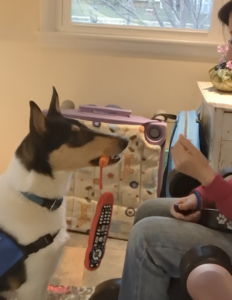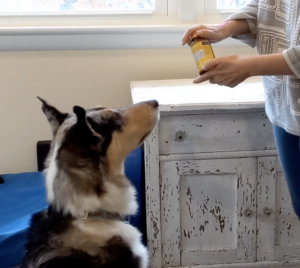Sometimes a service dog needs to pick up an item very precisely. For example, they may need to pick up a medication bag by the handle in order to prevent damage to the medication inside, or the dog may need to turn their head to pick up a medication bottle from a shelf without knocking it over. There are several strategies that can help with training a service dog to pick up an item precisely.
Create a handle so the item is easier for the dog to grab
With items like remote controls and cell phones, it may be impossible for the dog to pick up the item without accidentally hitting a button. Creating a handle that is easier to grab can make a big difference in the dog’s ability to be successful at the task. There are a variety of cell phone bags with handles that a service dog can be trained to pick up. Some have plastic windows so the handler can use the phone without removing it from the bag. Silicone remote control cases offer the added benefit of providing some protection if the dog accidentally drops the remote. Most come with small lanyards that can be made wider with some foam tubing, making them easier for the dog to hold. Creating a handle that has a distinct color or appearance and is comfortable for the dog to hold will make it more likely that the dog picks up the item by the handle.

Break down the generalization process into smaller steps
Training a dog to pick up an item by the handle is an advanced retrieve skill, so it is important that all of the steps of the retrieve have been previously trained to fluency via back chaining and that the behavior is well generalized. When beginning to teach the dog to pick up the item by the handle, if it is possible to separate the handle from the bag or case, that can make the process easier. Work just teaching the dog to pick up the handle before attaching it to the item. When the dog is readily retrieving the handle, you can attach the handle to the item. Begin generalizing by holding the item in a position that makes it easier and more likely that the dog will grab the handle rather than grabbing the item in another way. Slowly work toward transitioning to positioning the item in different and more challenging ways.
Change the position of vertical items slowly
When a dog is learning to grab a bottle from a raised surface like a countertop, they need to turn their head before grabbing the item or they will knock it over and it will fall on the floor. This is another advanced skill and not appropriate for a dog who is new to retrieving.
Begin by holding the bottle horizontally, so it is easy for the dog to take and hold. Mark and reward early, just for the take. After a few repetitions, turn the bottle slightly diagonally, so the dog has to turn their head a little bit in order to take it, and again mark and reward early for the take. Repeat the process as you slowly work toward holding the bottle vertically. If the dog seems confused, take a step back in the training process. When it is easy for the dog to turn their head to take it when you are holding it vertically, you can place it on a low countertop and place your hand over the top of it. That way the dog cannot knock it over but you can still mark and reward early when the dog turns their head to take it. Work incrementally toward fading out having your hand on top of the bottle and build fluency.
If the dog is struggling to perform a precise pickup as needed, in some cases this may reflect a dental or oral health issue, or it may simply be an unrealistic task. When training this behavior, as is true for any service dog task, always consider whether there are ways you can make the job easier for the dog. For instance, it may help to make a handle wider or out of a different material, or to put a cover on the item that the dog will find easier to grab. Consider the dog’s comfort; it may take a bit of experimentation to modify a cover or handle. If the dog continues to struggle, the best approach may be to take a step back in the training process to work longer on refining a foundation behavior. With creativity, precision and patience, this fine-tuned behavior is a very attainable goal for most service dogs.

